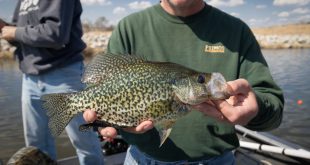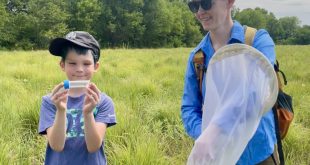The Rutten Family of Cedar Rapids Pass on a Hunting Tradition
Enlarge
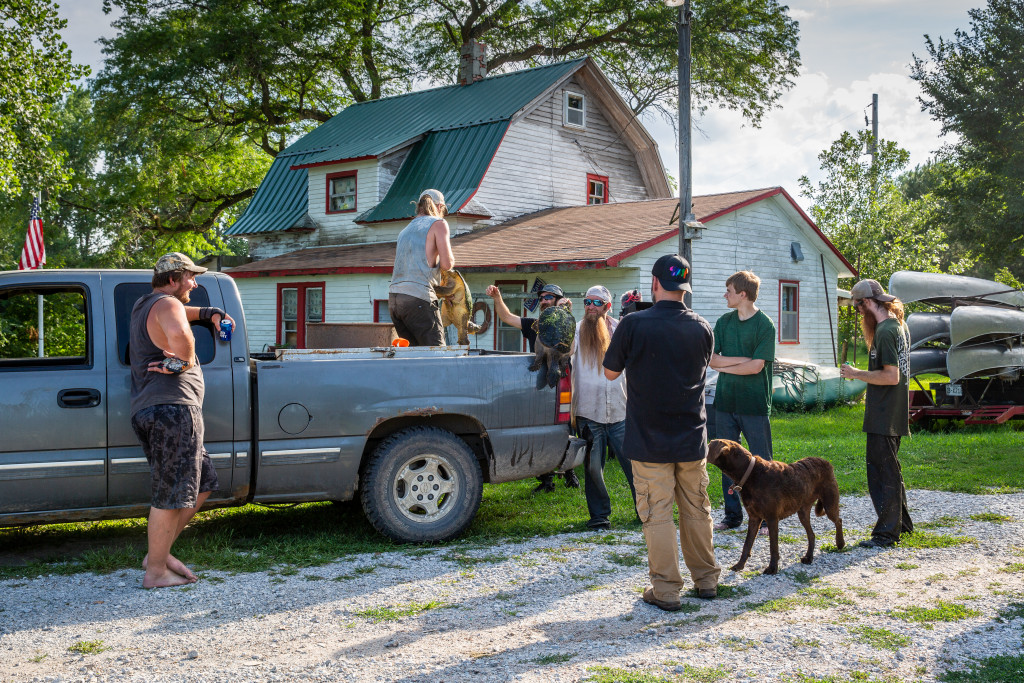
Story and Photos by Jenny Nguyen-Wheatley
The Ruttens of Cedar Rapids do something that no one else does: hunt snapping turtles with their bare hands. Every summer, the Rutten “boys” — geared in old tennis shoes, jeans and a T-shirt — ease down into the greasy, stagnant oxbow lake on the flood-prone family property, called “The Island.” Each man carries a pitchfork, while other family members wait on the bank ready with gunny sacks.
Walking abreast, the hunters blindly poke at the odorous, muddy water. The swamp is full of clay-like mud, snags and vegetation, and the effort is slow going. They’re looking for that familiar “thunk” sound — that’s when they know there’s a snapper near their feet. The tone of a pitchfork tine bumping against a turtle’s back is different than the sound that a log would make, says Ben Rutten, the family’s patriarch. You only need to hear it once, then the sound becomes unmistakable.
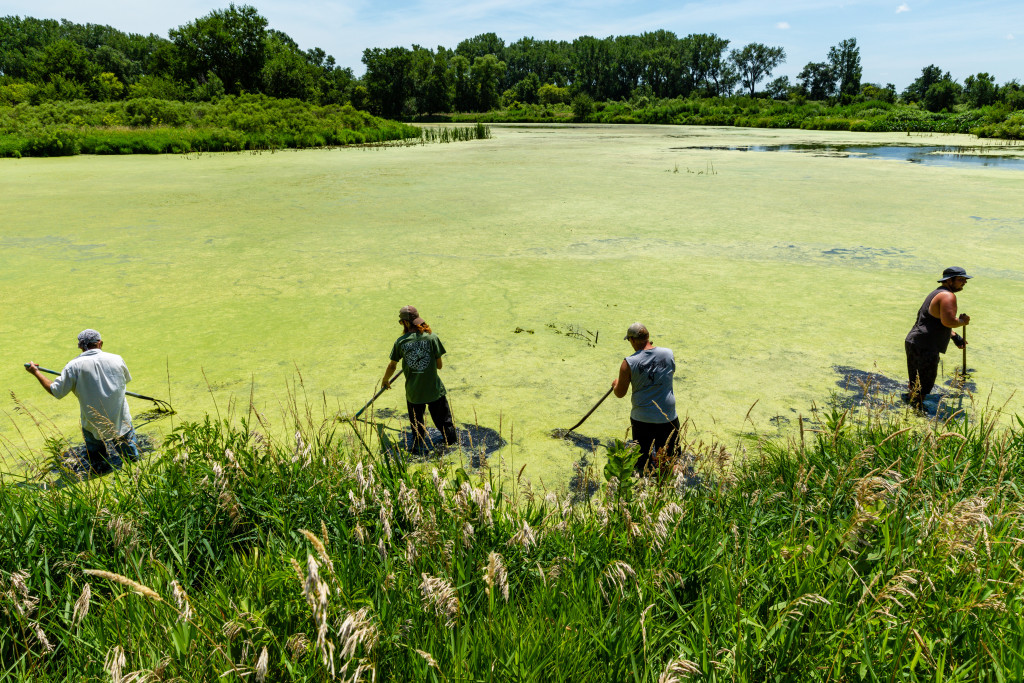
When a snapper is located, heart-pounding excitement ensues. The hunter who found it quickly applies gentle pressure onto the turtle’s back with one foot — just enough weight to pin down the animal and give others time to wade up and help. Then comes the harrowing part: getting the pitchfork underneath the turtle to lift it from the water and grabbing it by the tail — and hopefully, not its agile, beak-like head.
The Ruttens are only interested in snappers of a certain size. Turtles less than 8 pounds are too small, and anything over 30 pounds is breeding stock and thrown back. Those that fit the criteria are carried onto the bank, where helpers on land transfer them to the pickup truck. In Cedar Rapids, the Ruttens are known for throwing the best parties. That’s why they hunt these aggressive reptiles. When cleaned and cooked well, snapping turtle can be delicious, and the Ruttens certainly know how to do it right.
Good to Eat
Turtle hunting started with Ben’s dad, Chic, and his uncle, Maurice, in the late 1930s. As boys, they would go down to the swamps along the Cedar River to catch turtles to bring to an old man in town who ate them. One day, Chic and Maurice decided to stick around to watch. The old man butchered and cooked the turtles, and then he sent the boys home with some to try.
“They ate it, and it was so good that they quit giving the turtles to that old guy and started eating it themselves,” Ben says, chuckling.
The hunting stuck. Almost 90 years later, Chic’s great-grandchildren still hunt turtles near the Cedar River and Beaver Creek. Ben and his younger sister, Kim Rutten Schilousky, are making sure the tradition stays alive. For Kim, the turtle hunts were always about family time. Her dad took her along as soon as she was able to go with her brothers: Ben, Sam, Dave and Jay.
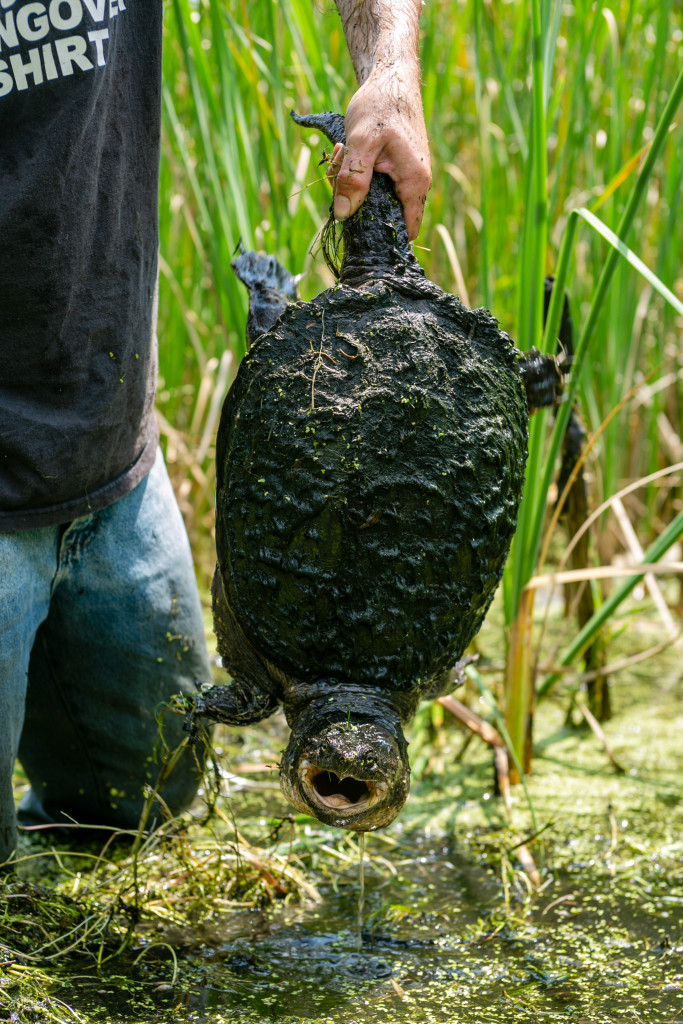
“I went everywhere the boys went,” Kim says. “Although, I’m sure that when my brothers got into high school, they weren’t as happy to have me going — you know, dragging your little sister with — but they never told me I couldn’t. We always try to include the entire family on these hunts. Our kids are raised the same way.”
Kim got into the swamp when she was a teenager, but prefers to be “the bag lady” — running the gunny sack up and down the bank wherever it’s needed. She also holds another important job. Since the passing of her mother, Ernie, Kim has taken over preparing the family’s favorite meal. The Ruttens’ steamed turtle recipe is tried and true. Anyone who is willing to taste it will not be disappointed.
An Underutilized Resource
“A lot of people won’t try turtle just because of what it is. It doesn’t sound good to eat something that comes out of a muddy, stinky swamp,” Kim says.
The old adage that turtle tastes like shrimp, goat, pork, fish, lamb, beef or chicken is not true. Thankfully, snapping turtle meat is not the Frankenstein of the swamp. Instead, it’s more like the pig – swamp pig. Slow-cooked the way the Ruttens do it, the look and taste is akin to slow-cooked pork. It’s chewing on the odd-looking reptile bones that screws with your head.
For over 10 years, Ben has demonstrated snapping turtle processing at the Missouri River Outdoor Exposition at Ponca State Park, and his slot arguably draws in the largest audiences each year.
At home, Ben can clean a turtle in under 5 minutes, but he takes it slow at Ponca. A turtle will butcher out about half its weight, he says, so a 20-pound turtle will give you approximately 10 pounds of meat and bone. He gets three pieces from each leg and cuts the neck and tail in half so they fit into the pan better. From one turtle, Ben can get 16 pieces of meat. Despite the grisly sight, Ponca Expo goers — young and old, male and female — continue to be mesmerized each year. Many are even brave enough to try a piece of Kim’s steamed turtle, and no one has ever had anything bad to say about it. Ben thinks his demonstrations are popular because they’re just different.
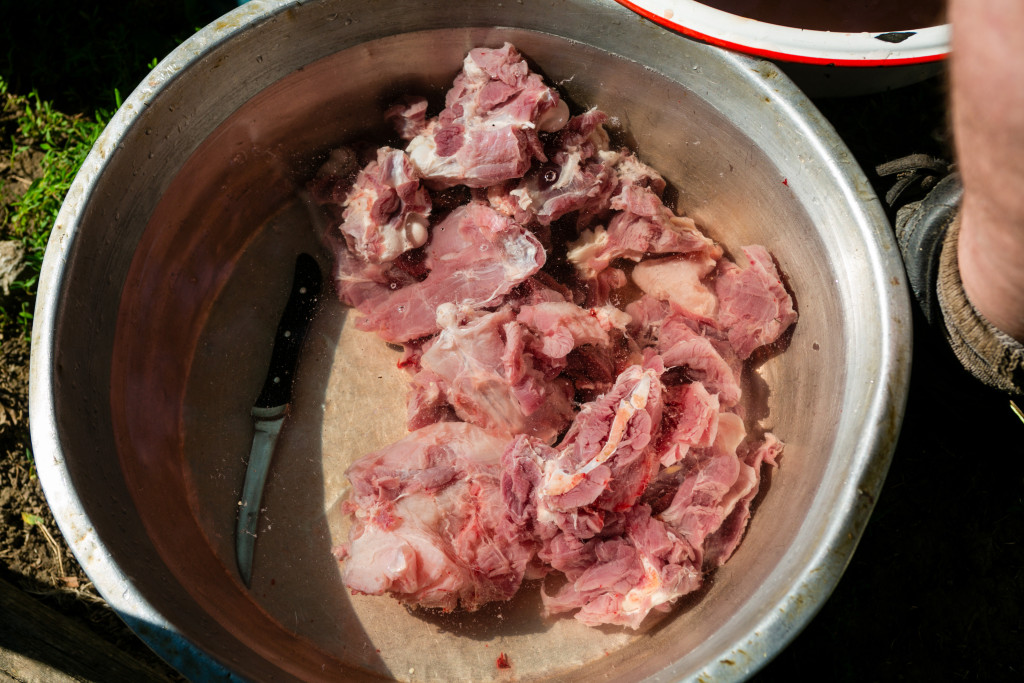
“It’s something people think they might want to do, because they’ve all caught a turtle on a fishing pole once or twice, or seen them crossing the roads. They think, ‘Well, if it’s worth eating,’ then they might want to try it. It’s a resource that is underutilized,” Ben says, although he’s not sure if anyone has ever made the leap to actually go through with it. He has seen many repeat audience members over the years.
“It’s a job to do it, and if you don’t clean them right, trim them up good, they taste bad. And then you got to cook them right, because they’re so tough. If you don’t steam them, then you can hardly chew them,” he says. “I’m probably pushing 800 turtles that I’ve cleaned in my life.”
When the Ruttens were still throwing large parties, Ben might clean 30-40 turtles a year. Now, he only cleans a few each summer and can still put all his nephews to shame.
“I get tired of watching them so I do it,” he says.
Turtle Party
The Ruttens’ “turtle parties” have become a part of Cedar Rapids’ town lore. When Chic and Ernie Rutten were still around and active, these gatherings were the social highlight of the summer season. Ernie and a couple of other ladies in town would fill three giant electric roasters full of turtle meat to feed what seemed like the entire community. Kim and the boys were expected to help in the garden and kitchen as soon as they were able, but only the women cooked the turtle.
“When it came to the turtles, mom ended up frying most of the day. I was probably 12 when I began helping with that,” Kim says. “The recipe hasn’t changed much over the years. That’s how mom taught us how to do it — just brown it in lard. Tastes better when it’s in lard. Of course, she did everything in lard.”
Once browned, Ernie would throw the pieces in a foil-lined electric roaster and put water underneath the pan. The turtle was covered with foil and steamed until done. Snapping turtle meat is tough, regardless of age. Generally, it takes three hours of steam time before the meat starts falling off the bone. Then, it’s ready to eat.
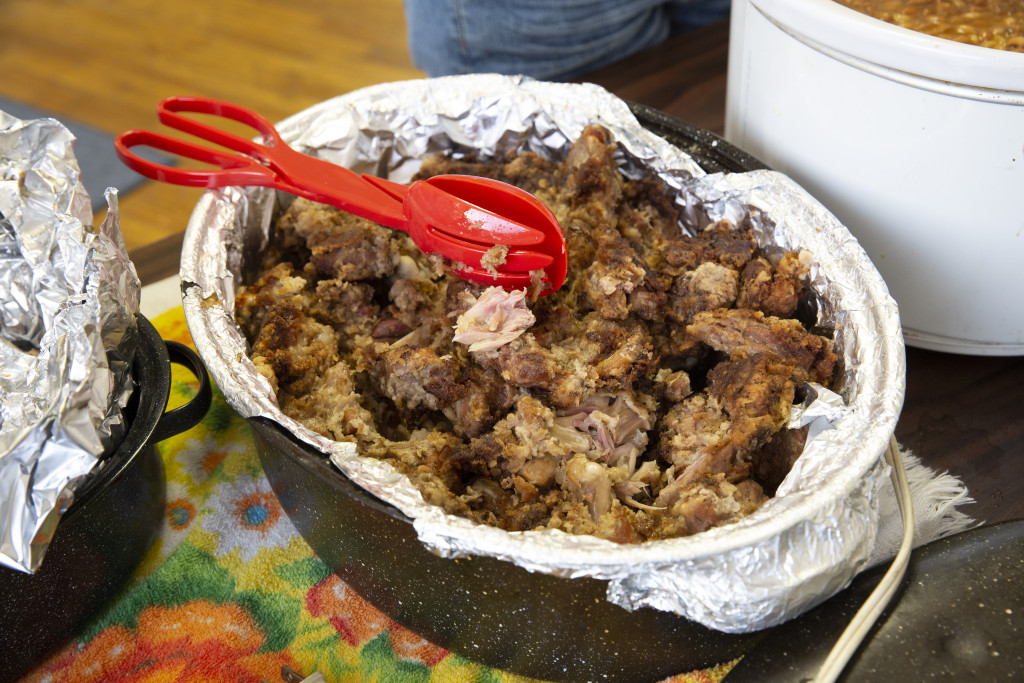
The “quonset party” of ’75, the year before Kim graduated high school, was the last big turtle party she remembers. A man who lived outside of town offered up his quonset for the party. Kim’s parents brought all of their friends, and all the guys who hunted invited their friends and family as well.
“We sat on hay bales and set up tables, and we brought all the food in — salads and turtle and some other meat. And we filled that quonset with people and danced and partied all night,” Kim says. “There were four local guys who had a band, and they came out and played, and we didn’t pay them for any of it. They were there to party and have fun, too. It was just a good time.”
And they went through a lot of turtle meat. Back in those days, the Ruttens typically butchered 60-70 turtles per year, and as far as Ben knows, they’re probably the only family who hunts turtles with any consistency in the state. They’ve hunted private swamps near Albion, Belgrade, Primrose, Spalding and Fullerton. After so many years, all the landowners know them. Turtle hunting isn’t like deer hunting. They can come and go, leaving little trace, and no one would mind.
Unfortunately, the days of the large turtle parties are gone. Now, gatherings are much smaller family picnics at the old house on The Island, typically after a hunt. Ben’s longtime partner, Doris Kolm, also helps Kim with the cooking.
“People don’t socialize like they used to anymore,” Kim says, wistfully. “You try to set something up, and then it’s ‘gee, I got something going on.’ I miss it. Every now and then, the older folks in town will mention it.”
Still, the family continues to enjoy the pastime. Although many of the original turtle hunters have passed on, the reins have been handed down to Kim, Sam and Jay’s children and grandchildren.
A Rutten Tradition
Kim’s daughter, Crystal, helps with the cooking now and even a couple of her nieces have tried walking the swamp with the boys. Her oldest grandson and nephews, who have tagged along since they were little, love to get in the swamp and take part in everything. Kim’s younger grandchildren enjoy the hunts, but they’re still at the stage of playing along the edge and getting muddy.
“We always called it a ‘Rutten tradition’, but it’s more and more coming down to my boys. Or, my boys are the ones left who still go and do it, but they don’t care. They still call themselves ‘Ruttens’,” Kim says.
Most parents might think that snapping turtles and children don’t mix, but Kim is never worried. A snapping turtle’s bite will hurt and leave a three-cornered cut, but it’s nothing a little Epsom salt can’t fix, she says. No one has ever come close to losing a finger. Kim is more concerned about broken glass or barbed wire in the swamp.

“I was never worried about being bitten because Chic always said that they didn’t bite underwater — which ain’t true,” Ben says, laughing. “But I never got bit. I’ve been clawed more than anything.”
Ben’s nephews have heard the same fib from Grandpa Chic, and perhaps it’s this foolhardiness that gets a young man going. However, not all hunters have been so lucky.
Ben recalled: “We went over to Uncle Dick’s in the spring one time, when the turtles were coming up to lay eggs. It’s always after a thunderstorm — I don’t know why — but it always brings the turtles up to lay eggs. I think we picked up about 20 turtles that day. Uncle Bud had two to three turtles in a gunny sack and threw it over his back and one of them bit him in the butt. Must’ve caught that nerve, because he went down like a sack of rocks and couldn’t get up. It wasn’t real funny to him, but the rest of us sure thought it was.”
Another fond memory: Ben’s dad had a collector’s permit, and if he found snapping turtle eggs, he’d plant them somewhere else to protect them from the raccoons. One year, Chic hatched out over 120 of them and took them down to the swamp. Today, Ben continues the practice. Even now on The Island, when he ditches the crops for irrigation, he usually finds a nest that the raccoons haven’t ransacked yet.
“I’ll go dig up the eggs and replant them. There are little turtles out there every year. I took one to Ponca last year and left it there,” he says.

Modern life offers a young person plenty of distraction. Ben recognizes that today’s generation can’t hunt like he and siblings used to, which was every weekend when they were in high school. But he and Kim are hopeful the Rutten tradition will continue.
“I think the boys will continue to hunt, and their kids probably will, too,” Ben says. “The swamps are getting filled in around here with all the flooding, but there are still a lot of turtles around. They might not work as hard as we did, but it’s still fun to go in and walk around. You see so many other things — the muskrats and frogs and red-winged blackbird nests. It’s just fun being out there.”
Ben is a retired Nebraska Game and Parks biologist, and his nephew Seth is following the same path. Turtles aside, Kim and Ben’s main hope is to instill appreciation for the outdoors in their successors. It’s apparent that they’ve succeeded. ■
 Nebraskaland Magazine
Nebraskaland Magazine
